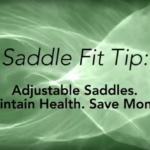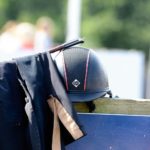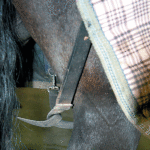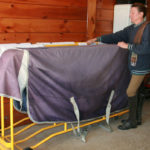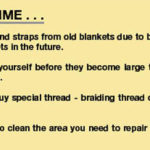If your tack room is like ours, blankets seem to breed in there. Manufacturers know that many of us own a whopping four to 10 blankets per horse. If you don’t think you have that many, go out and count them.
One trend in blanket design is a system of several layers that can be mixed around to match the weather conditions and then hooked together. You can buy four or five matching layers and use two or three of them at a time in a single unit during the colder months.
If you’ve owned your horse for several years, you already have plenty of blankets and you probably won’t want to add a pricey blanket system to the stack. But if you bought a new horse over the summer and you need to outfit it for winter, you may want to consider a system instead of buying several separate blankets.
Manufacturers have taken different approaches to the idea of a blanket system. Some offer layers that are designed to only work together and not separately and are priced as a unit. It’s more usual, however, to have layers of different types that are priced individually but work together, like buying separates at a clothing store.
Some have a choice of materials (fleece or polyfill with nylon or poly/cotton covers) in addition to a choice of attachments and a choice of whether or not the liners can be used on their own without the top layer. The top layer is usually a waterproof blanket or sheet with surcingle and leg straps (attached or detachable leg straps).
We have our own idea of the perfect system:
1. A cotton sheet next to the horse’s skin.
2. A choice of two weights of mid layers (one being fleece).
3. A turnout sheet on top that would be truly waterproof and breathable.
Each layer would have detachable elastic leg straps so the layers could be used separately, but the bottom straps could be removed if three blanket layers were used as a unit. This would provide a stable sheet, stable blankets and a turnout that could easily cover the changing seasons and be easy to launder without depriving the horse of protection for several days. We prefer detachable straps because if one breaks it can be replaced without sending the blanket away to be repaired.
None of the systems sent to us met this “ideal” configuration, particularly those that didn’t have straps for the liners, although some offer the extra straps as options. There’s almost an infinite way to combine three different layers into one unit, and the manufacturers have sound reasons for their varied products. Most offer enough options so that consumers ought to able to get exactly what they want, although they may have to pay more for it.
Kensington, for example, has two systems aimed at different markets. The K4S, which is sold as one unit, doesn’t have separate straps for the layers. This system is intended for the person who ships their show horse from place to place in the winter, say from Colorado to California. Instead of clogging the trailer with four or more blankets (or arriving with something too heavy and buying yet another lighter blanket), there is one unit hooked together that can be changed when climates change.
The Kensington 2002 Roustabout system, on the other hand, has layers that are purchased separately so you can customize it to meet your needs and each layer can be used separately.
Our testers, in a busy eventing barn, anticipated a winter of convenience and versatility with the systems, but at first they found just the opposite. Adding or removing layers, when they are all attached together, can be time consuming. Instead of changing the system when they were rushed, they were tempted to just grab another blanket in their tack room. They ended up liking the systems, not so much because of convenience but because the systems provided some distinct uses that their horses’ wardrobes didn’t.
If you purchase a blanket system, your satisfaction will depend on the pieces you choose for your specific needs and your climate. If you live in Canada and turn your horses out in any weather, your needs will be different from someone who lives in North Carolina and rarely turns out and/or from someone who spends the fall in New York, the winter in Florida and the spring somewhere in-between.
The choice and weight of materials are key. Cotton is least likely to slip, is breathable and is easy to wash. Fleece is warmer, breathable and also easy to wash. Nylon/poly is the warmest and bulkiest. It also can slip and can be harder to launder, depending on the filling.
You may also want to pay more for real “waterproof/breathability” so your horse will be comfortable outside in rough weather but won’t start to sweat if the sun comes out. There is no industry standard for these terms. A blanket that is truly waterproof/breathable has a membrane that is laminated inside the top layer to keep rain out while allowing vapor (sweat) to escape, and this quality adds significantly to the price.

When you add a lot of layers it can also cut down on breathability. Thus, the nylon used over polyfill on the lower layers may be a lighter grade than that found on solo blankets, and thus the liners run the risk of tearing when used without a cover sheet. “Every choice you make means there’s a compromise to be made,” said Michael Libertucci of Saratoga Horseworks Ltd.
Blanket systems have one distinct advantage over other winter blankets. Because there are several thinner layers that come apart, they can be laundered separately in a home washing machine. This saves the time and bother of sending winter blankets out to be cleaned and it also saves the need to have a second blanket available while the first one is gone for a couple of weeks.
Kensington K4S (909/469-1240)
MSRP: $399.
Sizes: 60-86”.
Layers tested: 1. Reversible polyfill liner with poly cotton on one side and nylon on the other; 2. Waterproof ripstop nylon turnout sheet; 3. Protective loose-weave 100-denier Textilene with 2000-denier ripstop outer sheet.
Colors: Black liner and sheet. Plum/navy/beige or rust/tan/black/white plaid protective sheet.
Features: Includes carry bag. Layers attach together with two front straps, one surcingle and detachable elastic leg straps. Fleece at withers. Long sides. Swivel D rings hold layers together so they don’t twist. Hood available.
Comments: Fit true to size. Shifted slightly when nylon side of liner was next to horse. Fine for a moderate climate. Well-made, with durable, high-quality materials. Excellent water resistance. Our model did so-so on breathability, but the manufacturer said inner coating has since been added to the nylon turnout sheet to make it breathable. Bottom two layers don’t have separate straps since this model is designed to be used as a unit with one or both bottom layers attached to the Textilene top sheet. Swapping layers took a bit of time. Priced as one unit. The protective outer sheet is a truly distinctive product and can be used by itself to cover all the seasons as an extremely durable summer sun/fly sheet, anti-sweat or cooling trailer sheet. It can also used over a winter blanket to prevent soiling and tearing. It has a loose weave, so it’s not totally waterproof, but rain does tend to run off so whatever is underneath stays pretty dry.
Kensington 2002 Roustabout (909/469-1240)
< P>MSRP: 1. Poly cotton sheet $69; 2. Nylon Kersey blanket $109-129; 3. Protective Textilene outer sheet $89-$129.
Sizes: 68-86”.
Layers tested: 1. Poly cotton reversable sheet; 2. 600-denier ripstop nylon-lined kersey blanket; 3. Protective loose-weave Textilene outer sheet.
Colors: Sheet and blanket, tan with black and red trim. Plum/navy/beige or rust/tan/black/white plaid protective sheet.
Features: Detachable tail flap, two front straps, detachable elastic leg straps. (Many options available to customize.) System of locking all the layers together, with detachable surcingles and leg straps to prevent redundancy if all layers are used. Layers can be used independently or with the others.
Comments: Fit true to size. Did not slip. Neck holes ran large. (We added darts for our Thoroughbred test horse to make the opening smaller, and it did not slip, rub or pull back.) With the cotton sheet on the bottom, warmth was suitable for moderate climate with light coat. Although the manufacturer didn’t intend to use it this way, we experimented by changing the order (sheet/protective sheet in middle/blanket on outside). This added a layer of air in the middle and made it toasty. Kersey blanket is super at wicking and warmth but was stiff and attracted shavings like glue if used on outside. Construction and materials are excellent. Locking system is easier to use than on the K4S. Good water resistence with protective sheet on outside and moderate with blanket on top. Excellent breathability, wicking obvious beads of moisture away from the horse while keeping him warm. We liked how the layers could be used in any combination, even though the locking system could be time consuming to change. Unlike the K4S, layers are sold separately. Outer sheet similar to KS4.
Schneiders (800/365-1311 or www.sstack.com)
MSRP: 1. Nylon liner $39.95; 2.DuraTech liner $34.95; 3. Fibrefill blanket $69.95; 4. Storm Shield turnout sheet $99.95.
Sizes: 60-86”.
Layers tested: 1. AdjustaFit nylon liner with cutback withers; 2. DuraTech liner with high withers; 3. Ocala midweight blanket with 420-denier nylon and 10-oz. Fiberfill; 4. AdjustaFit Storm Shield 1200-denier woven poly turnout sheet.
Colors: Black liners. Navy, hunter or burgandy blanket. Navy with green trim turnout sheet.
Features: Two front straps. Top sheet has adjustable withers, shoulder gusset, bias surcingles, attached nylon leg straps, long sides. Blanket available with closed front and attached straps or open front with detachable straps and adjustable withers. Liner has reinforced strap slots and is not designed to be used alone. Detachable leg straps are optional.
Optional layer: Polar Fleece belly-wrap liner $39.95.
Comments: Fit true to size. Excellent warmth. Designed to have a choice of light or heavy liner used with blanket and/or turnout sheet. We experimented and used all four layers on bitter cold nights. Materials and construction were fine except that leg straps on blanket ripped off twice, so consider the option of D-rings and elastic detachable straps instead. We loved the adjustable shoulder/neck. Water resistance was fine on turnout sheet. Moderate breathability. The combination of layers was versatile, with a proper stable blanket that linked nicely with either liner (or both) and the top sheet, which kept the blanket clean inside. Each layer sold separately.
Saratoga Micro-Climate System (800/848-1914 or www.horseworks.com)
MSRP: 1. Primaloft liner $126; Triad shell $199.
Sizes: 68-84”.
Layers tested: 1. 2011 6-oz. Primaloft 3-ply quilted nylon liner; 2. 2009 Triad outer shell, with Propex, sewn over CoolMax and laminated with waterproof/breathable membrane.
Colors: Shiny black liner. Navy, red, royal, black or Black Watch shell with black trim.
Optional layers: 3-oz. Primaloft liner $108; black PolarTec 200 closed-front fleece liner with nylon chest guard $94; Cordura shell lined with nylon $148. Many optional features to customize.
Features: Elastic attached leg straps on shell, surcingle with elastic insert, two chest straps with Velcro closure. Liner has closed front and is available with or without surcingle and detachable straps. Durable Acetal snaps. Shell has long sides to cover liners.
Comments: Fit ran small, so we suggest ordering a size up. Slick nylon lining tended to shift a bit. Excellent warmth, even with just two layers, and six-ounce liner is too warm for late fall/early spring. Using the entire system, you can go from ???10?° using the six-ounce Primaloft liner to 45?° with just the shell. Beautiful materials and construction. Excellent water resistance and breathability. Fasteners that join the pieces together are logically placed and easy to used. Helpful instruction book for matching layers. Each layer sold separately.
Glover (204/534-7050 or www.gloverequine.com)
MSRP: Nylon polyfill liner $72; Rain sheet $139. Under 68” lower cost; over 82” more.
Sizes: 36-100”.
Layers Tested: 1. 600B polyester fill quilted nylon liner; 2. 501B. waterproof Glovertex 1000 denier Cordura rain sheet with tricot lining.
Colors: Black liner. Rain sheet navy with green trim or green with navy trim.
Features: The shell has raincap at withers, flexible tail cover, two-strap front closure, attached leg straps (detachable is option) and single girth. Liner has single front closure and reinforced slits for rain sheet’s leg straps, so liner doesn’t shift. Optional surcingle and detachable elastic leg straps for liners.
Optional layer: Polar Fleece liner $72.
Comments: Fit is roomy. Rain sheet has boxy construction with hip darts to prevent slipping and high neck. Liner is contoured. Warmth is moderate with the quilted liner. Fleece layer would be added for colder climates. Excellent construction and materials. Water resistance and breathability are excellent for turnout use. Layers are easy to attach. Performed beautifully. We would add the optional straps to the liners for versatility. Polar Fleece option can be used as a sole liner or mid-layer for added warmth. Each layer is sold separately.
Bottom Line
System blankets aren’t inexpensive, but buying three layers at once can actually be cost-effective, especially if you’re shopping for an entire equine wardrobe.
Your particular needs will determine your own choice???and these are all lovely blankets???but our first choice, by a whisker, is the Schneiders, with a versatile selection of layers (use the detachable straps for the blanket). It’s also a bargain at $205 for three layers and clearly our Best Buy. A close second is the Kensington 2002 Roustabout, which is well-made, versatile, looks smart and has the bonus of a layer that can be used in the summer for about $300.
The others all have their special advantages. We found the highest-tech fabric and design in the Saratoga Micro-Climate system, which comes with instructions. The Glover set performed extremely well and was the most convenient to change layers, at a reasonable $283 for three pieces. The most intriguing design and best for travel was the pricey Kensington K4S.



